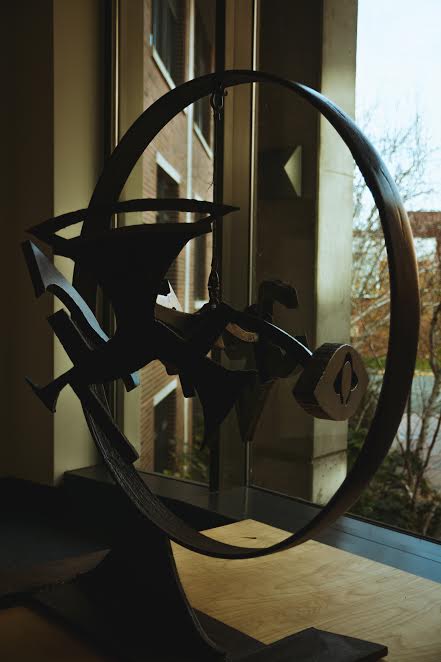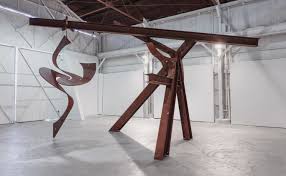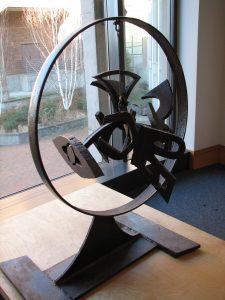Mindseye, Mark di Suvero (1978)
 Mark di Suvero is an internationally renowned sculptor that was born in Shanghai, China in 1933. Eventually Di Suvero immigrated to San Francisco, California with his family due to the outbreak of World War ll. He graduated from the University of California Berkley with a B.A in philosophy. During his college career Di Suvero began creating sculptures when he realized he couldn’t make an original contribution to his philosophy major. After graduating college, Di Suvero moved to New York in hopes to pursue a career in sculpting. In New York, Di Suvero worked part-time in construction and began to incorporate wood and metal from demolition sites into his work. During his career Di Suvero suffered from a broken spine due to a near-fatal elevator accident while working at a construction site. During his rehabilitation, he worked with an arc welder that gave him skills to create some of his future works. Di Suvero eventually had his work in over 100 museums and public collections all over the world.
Mark di Suvero is an internationally renowned sculptor that was born in Shanghai, China in 1933. Eventually Di Suvero immigrated to San Francisco, California with his family due to the outbreak of World War ll. He graduated from the University of California Berkley with a B.A in philosophy. During his college career Di Suvero began creating sculptures when he realized he couldn’t make an original contribution to his philosophy major. After graduating college, Di Suvero moved to New York in hopes to pursue a career in sculpting. In New York, Di Suvero worked part-time in construction and began to incorporate wood and metal from demolition sites into his work. During his career Di Suvero suffered from a broken spine due to a near-fatal elevator accident while working at a construction site. During his rehabilitation, he worked with an arc welder that gave him skills to create some of his future works. Di Suvero eventually had his work in over 100 museums and public collections all over the world.
Mark Di Suvero’s early works consisted of large outdoor sculptures that incorporated timber, tires, scrap metal, and primarily steel. As time passed his work became more focused on H-beams and heavy steel plates. Many of his pieces have the function of motion with pieces that swing and rotate. These sculptures are made with a hands-on approach.
“I want my work to be poetry” Mark Di Suvero claims. His work is often interactive, and as an artist he invites viewers to touch and interact with his work. He wants to evoke feelings in the viewer, no matter what those feelings may be. Although there is no definite meaning to the work Mindseye, this is done intentionally so the viewer may interpret the sculpture however they please. Since Mindseye is in such an occupied space, many people have laid eyes on it as they cross the sky bridge between the library and Haggard hall
Viewer Interpretation “When I saw the sculpture Mindseye by Mark di Suvero what I first noticed was its unique structure and rustic elements. The structure consisted of a metal ring, attached to that ring was a wire that held jumbled and somewhat abstract pieces of interconnected metal. An interactive aspect of this sculpture is the ability to be able to spin the abstract pieces of metal connected to the ring. When doing so there is a visible eye that stands out within the abstract pieces. When I see this sculpture, and relate it to the name Mindseye, I see what Mark di Suvero was trying to convey. I believe that through the abstract pieces of metal our mind immediately draws us to the structure most similar to an eye. Our minds often look at abstract pieces trying to find something familiar, that we can understand. An eye is a symbol that most are familiar with, and that’s why it stands out in the sculpture.
The components used to create this sculpture was a metal that was somewhat rusted and looked to had gone through some wear and tear, the metal was not smooth and had chips and dents in it, the wire was frayed and looked like it could perhaps snap in the future. It was not the best metalwork, but I believe the artist made this sculpture for the purpose of the viewer taking a look at the way their mind works, something that they wouldn’t usually do on the daily. I feel like Mark di Suvero’s piece wasn’t exactly the most aesthetically pleasing in my eyes, but it conveyed a unique idea that the mind is what makes us see and interpret things a certain way, even if it is just abstract metals.” -Kailey Cleveland
Mindseye is a sculpture made for viewers to interpret as their own, to give them an experience and evoke emotions within them. It is not meant to convey a certain idea or concept, but to have viewers interpret the sculpture brings creativity and imagination to their minds. At times, creativity and imagination can bring more value to a viewer than simply an artist conveying their ideas to those viewers through their medium, Mark di Suvero’s sculptures do just that.
Media Credits: Wylie Jacoy, Kailey Cleveland, and Nick Saunders



Leave a Reply